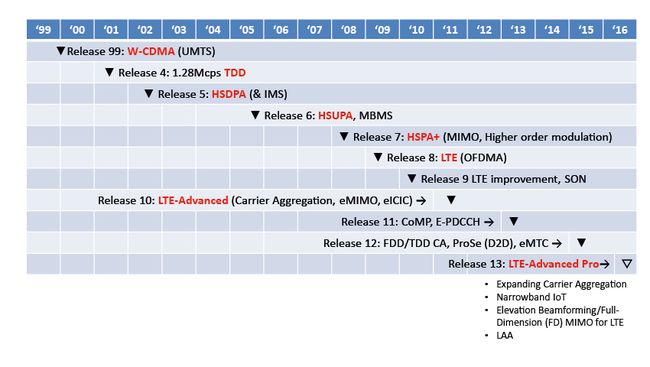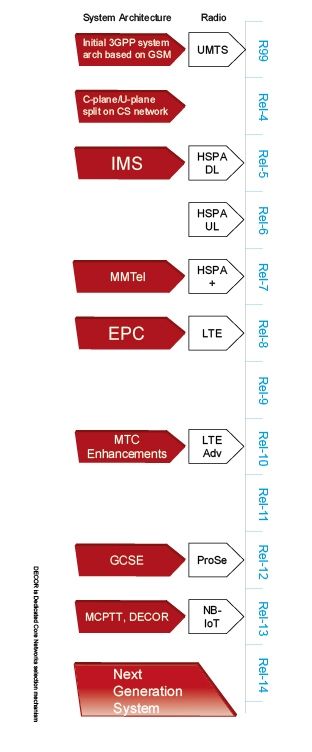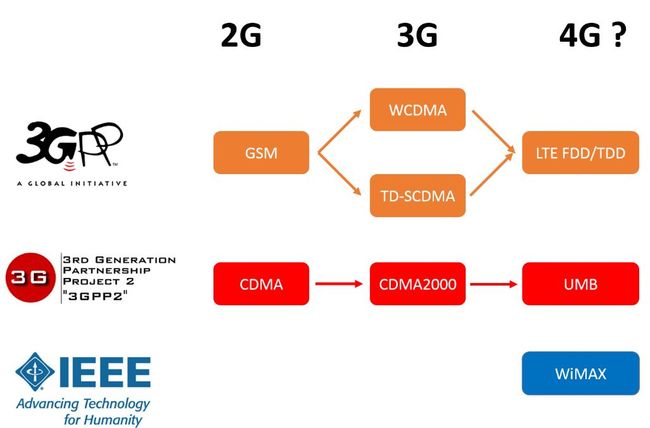Outline
The 3rd Generation Partnership Project (3GPP) unites 7 telecommunications standard development organizations:
- ARIB
Association of Radio Industries and Businesses (Japan) - ATIS
Alliance for Telecommunication Industry Solutions (USA) - CCSA
China Communications Standards Association - ETSI
European Telecommunications Standards Institute - TSDSI
Telecommunications Standards Development Society, India - TTA
Telecommunications Technology Association (Korea) - TTC
Telecommunication Technology Committee (Japan)
They are known as “Organizational Partners” and provides their members with a stable environment to produce the Reports and Specifications that define 3GPP technologies.
The project covers cellular telecommunications network technologies, including
- radio access
- core transport network
- service capabilities
including work oncodecs,security,quality of service, and thus provides complete system specifications.
The specifications also provide hooks for non-radio access to the core network, and for interworking with Wi-Fi networks.
3GPP specifications and studies are contribution-driven, by member companies, in Working Groups and at the Technical Specification Group level.
The 3 Technical Specification Groups (TSG) in 3GPP are:
- Radio Access Networks (RAN)
- Services & Systems Aspects (SA)
- Core Network & Terminals (CT)
The Working Groups, within the TSGs, meet regularly and come together for their quarterly TSG Plenary meeting, where their work is presented for information, discussion and approval.
Each TSG has a particular area of responsibility for the Reports and Specifications within its own Terms of Reference (Details available in the Specification Groups pages).
The last meeting of the cycle of Plenary meetings is TSG SA, which also has responsibility for the overall coordination of work and for the monitoring of its progress.
The 3GPP technologies from these groups are constantly evolving through Generations of commercial cellular / mobile systems (see table below). Since the completion of the first LTE and the Evolved Packet Core specifications, 3GPP has become the focal point for mobile systems beyond 3G.
Although these Generations have become an adequate descriptor for the type of network under discussion, real progress on 3GPP standards is measured by the milestones achieved in particular Releases. New features are ’functionality frozen’ and are ready for implementation when a Release is completed. 3GPP works on a number of Releases in parallel, starting future work well in advance of the completion of the current Release. Although this adds some complexity to the work of the groups, such a way of working ensures that progress is continuous & stable.
Backward Compatibility
The major focus for all 3GPP Releases is to make the system backwards and forwards compatible where possible, to ensure that the operation of user equipment is uninterrupted. A good current example of this principle has been the priority placed in the working groups on backward compatibility between LTE and LTE-Advanced, so that an LTE-A terminal can work in an LTE cell and an LTE terminal works in the LTE-A cell.
Radio Access Milestones
3GPP Technical Specification Group RAN, like other TSGs, ensures that systems based on 3GPP specifications are capable of rapid development and deployment with the provision of global roaming of equipment. Some of the headline 3GPP radio technologies and systems over the recent Releases have been:
All of these advances have provided a high degree of continuity in the evolving systems, allowing existing equipment to be prepared for future features and functionality, delivering higher data rates, quality of service and cost efficiencies.
Each progressive 3GPP radio access technology aims to reduce complexity and avoid fragmentation of technologies on offer.
Core Network Evolution
GSM networks used circuit-switch telephony initially, with packet-switching added with GPRS. In the UMTS architecture, this dual-domain concept was kept on the core network side. Some network elements were evolved, but the concept remained very similar.
When considering the evolution of the 3G system towards LTE, the 3GPP community decided to use IP (Internet Protocol) as the key protocol to transport all services. It was therefore agreed that the Evolved Packet Core (EPC) would not have a circuit-switched domain but that the EPC should be an evolution of the packet-switched architecture used in GPRS/UMTS.
This decision had consequences on the architecture itself but also on the way that the services were provided. Traditional use of circuits to carry voice and short messages needed to be replaced by IP-based solutions in the long term.
Generation & Major Systems Milestones
1G
Analogue technology, from the 1980s onwards.
Various technologies were deployed, Nationally or Regionally, including:
- NMT (Nordic Mobile Telephone) -> used by Nordic countries/Netherlands/Switzerland/Eastern Europe/Russia
- AMPS (Advanced Mobile Phone System) -> used by the USA/Australia
- TACS (Total Access Communications System) -> used by the Britain
- A-Netz to E-Netz, Radiocom 2000 -> used by France
- RTMI (Radio Telefono Mobile Integrato) -> used by Italy
- JTACS (Japan Total Access Communications System) -> used by Japan
- TZ-80n -> used by Japan
2G
First digital systems, deployed in the 1990s introducing voice, SMS and data services.
The Primary 2G technologies are:
- GSM/GPRS & EDGE (ETSI)
- CDMAOne (QUALCOMM)
- PDC (Personal Digital Communications -> Japan)
- iDEN
- IS-136 or D-AMPS.
The technologies used in 2G are FDD.
3G
The 3G system from 3GPP is based on evolved Global System for Mobile communication (GSM) core networks and the radio access technologies that they support.
This has allowed for the maintenance and development of GSM, with the evolution of General Packet Radio Service (GPRS) and Enhanced Data rates for GSM Evolution (EDGE), as well as further developments with the Universal Mobile Telecommunications System (UMTS) and High Speed Packet data Access (HSPA).
3G brought a global vision to the evolution of mobile networks, with the creation of the International Telecommunication Union(ITU) 's family of International Mobile Telecommunications - 2000 (IMT-2000) systems which included EDGE, CDMA2000 1X/EVDO and UMTS-HSPA+ radio access technologies.
- WCDMA (which comes from GSM) -> instituted by 3GPP (which involves ETSI) -> used Globally
- CDMA2000 -> instituted by 3GPP2 (which involves QUALCOMM) -> used by the USA
- TD-SCDMA -> instituted by CHINA MOBILE -> used by China
WCDMA/CDMA2000 apply FDD.
TD-SCDMA uses TDD.
3G/4G
LTE and LTE-Advanced have crossed the “generational boundary” offering the next generation(s) of capabilities. With their capacity for high speed data, significant spectral efficiencies and adoption of advanced radio techniques, their emergence has been the basis for all new mobile systems from Release 8 onwards.
LTE leverages FDD or TDD (aka TD-LTE)
It should be noted that LTE-Advanced (From Release 10) is 3GPP's ITU-R IMT-Advanced radio interface. LTE-Advanced is the FIRST TRUE 4G technology to be specified by 3GPP.
LTE-Advanced Pro is the name that helps the industry describe what has been achieved with the completion of Release 13. LTE Pro is set to be used by other sectors, beyond telecoms, including Critical Communications (blue light services & other Mission Critical systems), the machine-to-machine or Internet of Things (IoT) sector, Transport (Rail, ITS, etc), Education and many other areas. LTE-Advanced Pro is 3GPP's stepping stone to 5G systems.





